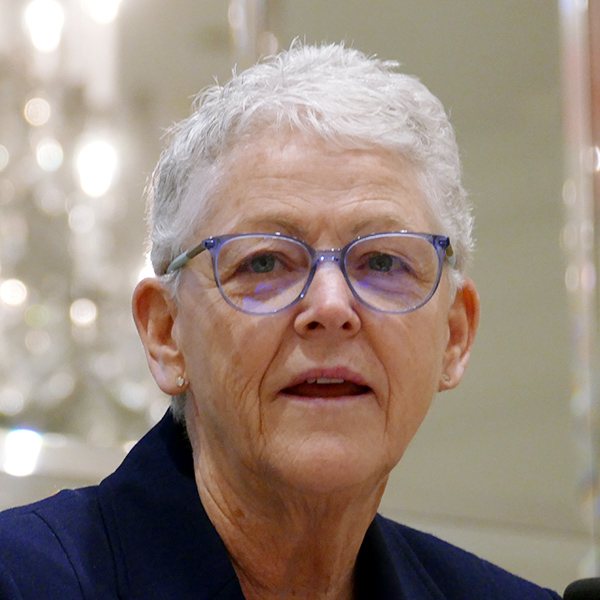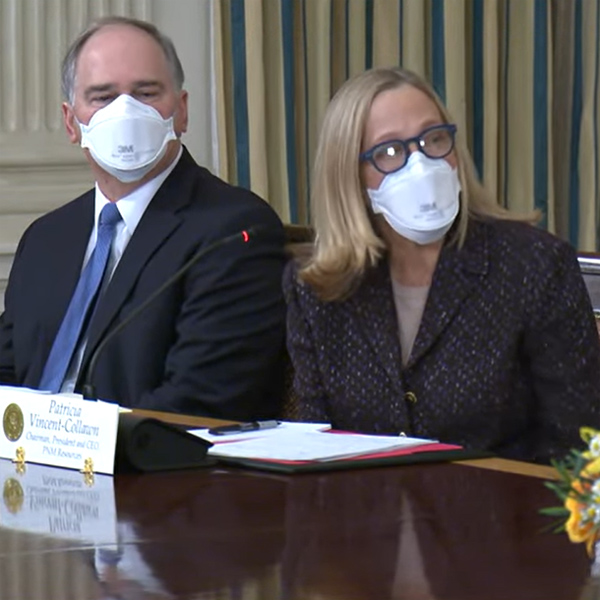
WASHINGTON — State and federal officials told the National Association of State Energy Officials (NASEO)’s Energy Policy Outlook Conference on Wednesday they are laser-focused on the millions of dollars that will soon be going to states from the Infrastructure Investment and Jobs Act and making sure that money has real impacts on people’s lives.
“If we align our federal resources and our state actions, we can actually deliver meaningful, real on-the-ground change that will be lasting, and that’s what we’re all hanging out in public service to do,” White House National Climate Advisor Gina McCarthy told more than 100 state officials and others in a ballroom at The Fairmont hotel in Georgetown.
“Let’s think about and talk about how we really focus attention in our states, in our communities, on how many jobs and how much economic opportunity that these investments will deliver,” McCarthy said. ”We are not asking for sacrifice. We are asking for government to serve its people and serve [them] well. … Let’s talk about this as meaningful to every human being. That’s the best way that we’re going to move forward.”
McCarthy’s speech capped a morning during which a range of officials from the Department of Energy (DOE) spoke — most virtually — about the money that will be available to the states from what they called the Bipartisan Infrastructure Law (BIL). Signed in November, the $1.2-trillion package includes $62 billion in energy funding.
 Gina McCarthy, White House National Climate Advisor | © RTO Insider LLC
Gina McCarthy, White House National Climate Advisor | © RTO Insider LLCOfficials urged states to prepare by appointing a coordinator to work across the different agencies that may be applying for funding or implementing programs. The need to get the money out to the states as quickly and efficiently as possible was another recurrent theme. Speaking in Tennessee on Tuesday, President Biden said the state allocations for the $5 billion in BIL funding to support EV charging are expected in the coming days.
At the NASEO conference, Kelly Speakes-Backman, who leads the Department of Energy’s Office of Energy Efficiency and Renewable Energy, provided a detailed breakdown of how the $550 million in Energy Efficiency and Conservation block grants will be distributed.
The BIL expands the block grant program so these federal dollars can be used to “include programs for financing, purchasing and installing energy efficiency, renewable energy and zero-emission transportation measures,” Speakes-Backman said. The formula for individual state allocations is still being worked out, she said, but “states are required to distribute at least 50% of their funds to units of local governments in their state that are not otherwise eligible for those [funds],” she said.
Another 2% of the funds are carved out for competitive grants to “eligible entities” — local governments and tribes — that cannot qualify for the state block grants, she said.
The $500 million for state energy plans requires each state to include “transmission and distribution planning,” Speakes-Backman said. “It adds an optional element for demand response. It clarifies [the] eligibility of electrified transportation, and it requires that state energy security management” is part of state plans.
Speakes-Backman stressed the DOE’s commitment to working with the states, noting that a recent “listening session” on the federal funding drew about 300 state officials and other stakeholders, and she promised additional meetings to gather state input.
Patricia Hoffman, acting assistant secretary for the DOE’s Office of Electricity, talked about the BIL funding for transmission, distribution and storage. The law includes $5 billion for transmission resilience and grid-hardening projects and another $5 billion for innovative storage and distribution projects, she said.
The resilience funding will be split between states and utilities, Hoffman said. “The goal of that is really to drive investments, and that is going to be focused around strategic goals with the states and what are the priorities that we want to invest [in],” she said.
The funding also includes a carve-out for small utilities, she said.
The $5 billion for storage and distribution projects will target riskier projects that will drive technology advancements, Hoffman said. The money will go to the states, and “the states really will partner with the public and rural electric cooperatives and other entities for innovative tech progress,” she said.
Not Giving up on Build Back Better
The focus on small communities and small utilities that might not normally be able to access federal funds reflects the Biden administration’s commitment to environmental justice (EJ), which McCarthy urged state officials to place at the center of their BIL-funded programs.
“We want to make sure that federal programs deliver at least 40% of the benefits to disadvantaged communities,” she said, noting that an EJ screening tool will soon be available to help the states develop these programs.
 PNM Resources CEO Patricia Collawn (right) speaks as American Electric Power CEO Nick Akins listens during a White House meeting with President Biden on the Build Back Better bill Wednesday. | The White House
PNM Resources CEO Patricia Collawn (right) speaks as American Electric Power CEO Nick Akins listens during a White House meeting with President Biden on the Build Back Better bill Wednesday. | The White House“We’re going to work together to make sure that our money goes where it needs to go … and really make sure that we’re showing the impacts of these resources every step of the way,” she said.
McCarthy also urged state officials not to give up on the stalled Build Back Better bill, which contains $555 billion in energy funding.
“We need to work together to get this Build Back Better over the finish line because we have no choice,” McCarthy said. “We will not succeed unless the United States of America invests in our own infrastructure. It’s not good enough to just put a half a buck in; we need to put in a buck and a half.”
Biden made his own plug for the BBB Wednesday in a meeting with utility CEOs, including American Electric Power’s Nick Akins and Duke Energy’s Lynne Good, who said the bill’s tax credits for renewables and energy storage would aid their transition to a low-carbon grid.
“This legislation is going to allow us to be carbon-free sooner, gives us renewable portfolio standards [and] allows us to securitize to keep costs down for customers,” said PNM Resources CEO Patricia Collawn.
She also praised the bill’s support for “a just transition,” citing funding for coal miners’ severance and retraining. “It has money for economic development in there to revitalize [tribal] communities,” she said. “Because when people move into the clean energy economy, they shouldn’t have to move away from their tribal lands.”
The Permitting Impediment
State officials at the conference were both excited and anxious about the challenges ahead in using the BIL funds for local projects.
Kenneth E. Wagner, Oklahoma’s secretary of energy and environment, said his department has been visiting D.C. since January to talk with DOE and White House officials about BIL.
“We’ve been all DOE all the time,” Wagner said during an interview with NetZero Insider. “We’ve got so many tentacles into this low-carbon economy that there are lots of pockets of money” for the state to tap into.
Oklahoma is talking with Department of the Interior about BIL funding for plugging abandoned mines and is looking for federal funds to expand the private investments the state has attracted in both hydrogen and carbon capture, Wagner said.
But Wagner sees permitting as a major impediment to the success of BIL. “We see the billions of dollars soon to be pushed out on demonstration [projects] and implementation at DOE and DOI,” he said. “Every single dollar has to have a NEPA assessment” to ensure compliance with the National Environmental Policy Act.
For example, carbon capture projects that inject carbon into the earth need a specific EPA permit — called a Class 6 permit — Wagner said, but he believes the EPA is understaffed for getting these permits out in a timely manner. “The left hand is pushing out money, creating demand, but we’re not seeing a corresponding push on authorization,” he said.

